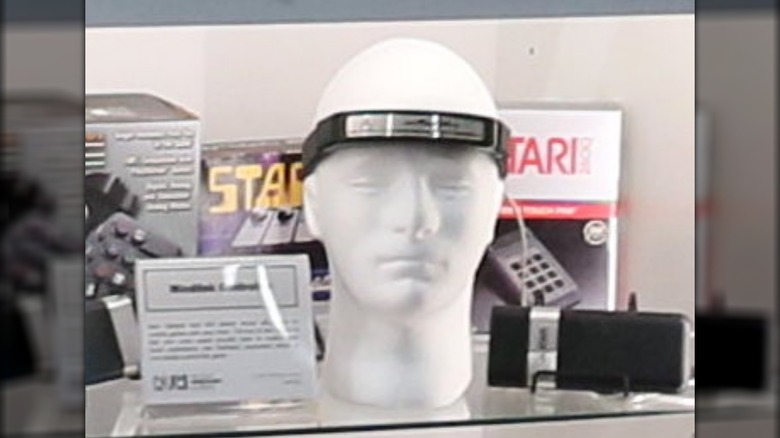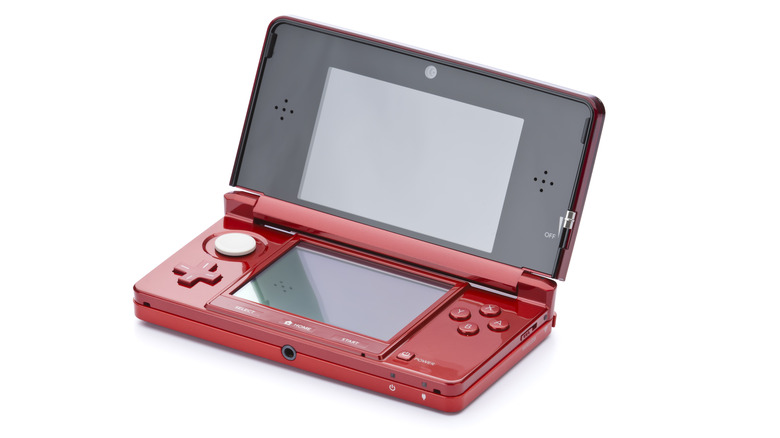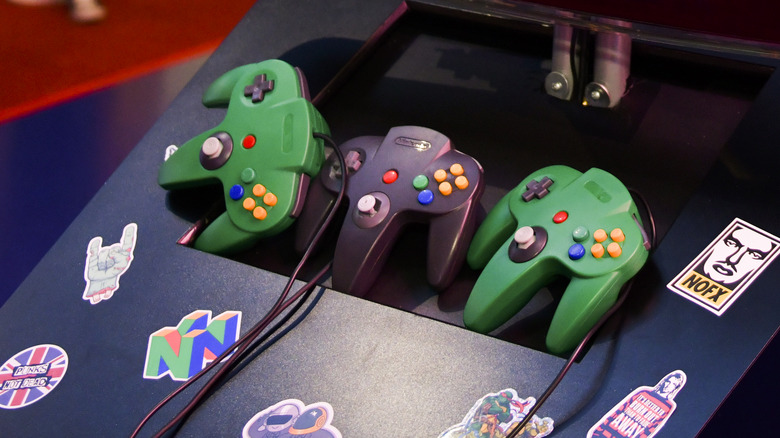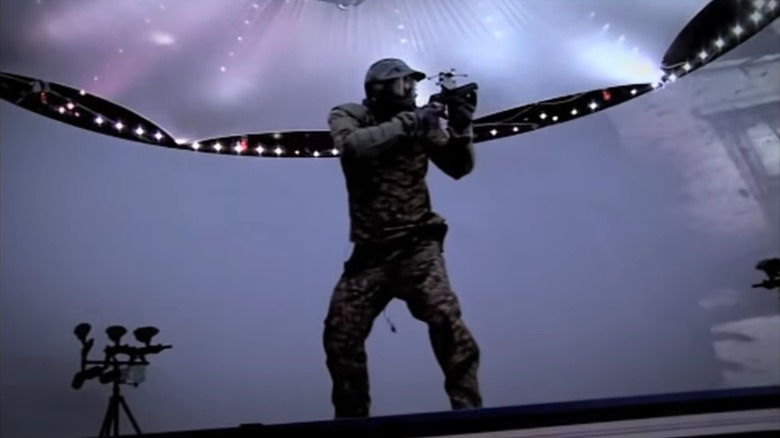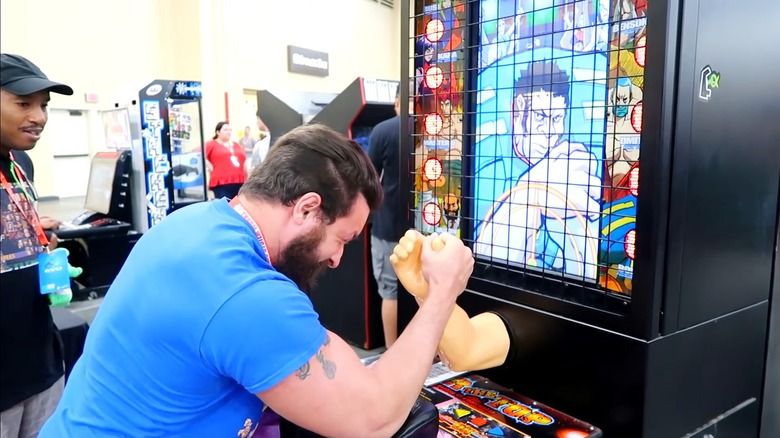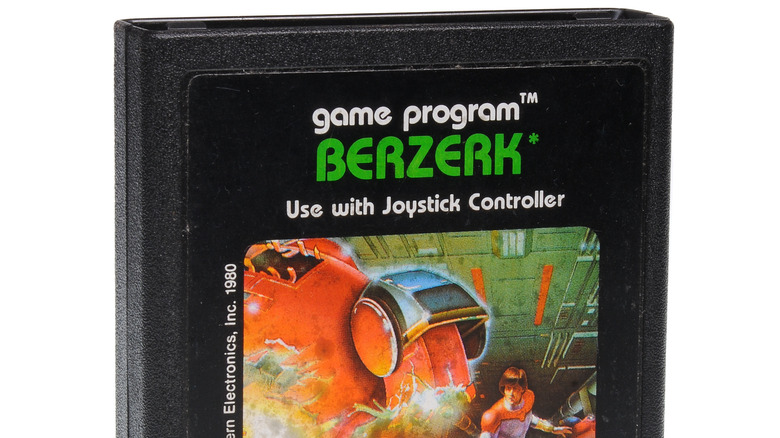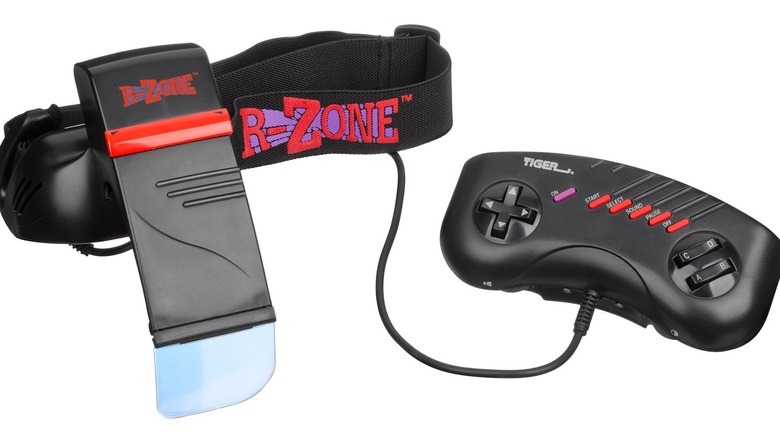10 Infamous Gaming Peripherals That Were A Pain For Their Users
Video game-related injuries are nothing new. Spend too much time in front of a screen while using a keyboard, and you're bound to develop eye strain and/or carpal tunnel syndrome. That's why you should try gaming in moderation, or with more ergonomic peripherals. Technically, you should always invest in ergonomic devices, but that's beside the point. The point is that you should avoid injuring yourself when gaming.
Most game peripherals are designed for comfort. For instance, many modern console manufacturers have learned the importance of designing holding prongs that follow the natural curvature of the hand while fingers are closed. However, this isn't always the case. Some controllers were poorly designed and were detrimental to hand comfort, or perhaps their flaws only surfaced when paired with specific control schemes. And when it comes to peripherals that were literally painful to use, controllers aren't the only potential subjects of focus. The video game industry is full of consoles, arcade cabinets, and even third-party accessories that have injured users.
By freak accident or by design, here are some gaming peripherals you probably would never want to use if you wanted to stay safe.
Virtual Boy
Nintendo has a long history of producing quality consoles and games. For a time, the company's crowning achievement was the Game Boy line of handhelds, which sold close to 120 million units. Gunepi Yokoi is often credited as the father of the Game Boy, and after that device proved successful, the Virtual Boy was supposed to be his next big hit. Instead, the console hurt its users, and its poor sales allegedly convinced Yokoi to quit Nintendo. But let's discuss the former issue.
The Virtual Boy was one of Nintendo's few failed gaming consoles, and it was a catastrophic failure at that. The concept was admittedly ambitious, as it would deliver games with stereoscopic 3D graphics (i.e., the same 3D technology used in 3D movies). However, the technology used to achieve this effect dug the console's grave.
Unlike other consoles of its time, the Virtual Boy projected monochromatic red and black graphics onto two screens enclosed in a headset, which tricked the brain into processing the result as a 3D image. However, this color palette caused eye strain and headaches in many users and could permanently damage the vision of younger gamers. To make matters worse, the Virtual Boy's headset was too bulky to just slip over someone's head, so to use it, players needed to place the console on a table and lean forward into it. Turns out the human spine wasn't flexible enough for this task, as reports of back pain from using the Virtual Boy were rampant. While the Virtual Boy was a dismal failure, at least Nintendo learned from its mistakes when it designed the much more successful Nintendo 3DS.
Atari Mindlink
Several decades ago, Atari was at or near the top of the video game industry. The company was responsible for crucial titles such as "Pong" and "Space Invaders," and it also manufactured household consoles over a decade before companies like Nintendo entered the market. Since controllers for Atari's consoles predated now-standard concepts such as d-pads, the company experimented a lot. Not every idea panned out, in one case because it was too painful to use.
During an early 1980s Consumer Electronics Show (CES), Atari announced the Mindlink, a headband that was supposed to detect myoneural signals in the forehead, translate them into game inputs, and beam them to Atari consoles via infrared transmitters and receivers. When Atari representatives showed their idea to CES attendees, the results were less than impressive — partially because viewers didn't know what to make of the peripheral, and partially because anyone who tried it walked away with a headache.
To make the Mindlink register anything, users had to move their eyebrows, which became a figurative and literal pain when the game used to demonstrate the device started to speed up. Furthermore, the controller itself could only translate these eyebrow motions into left and right movements in games. Atari promptly canceled the Mindlink after its poor CES reception. A shame, since Olympic athlete Jafer Johnson allegedly wanted Atari to produce a Mindlink-like device for use in the Special Olympics, and the Rose Kennedy Foundation was going to foot the cost of development. With that kind of funding, Atari could have made an updated Mindlink that was more robust and less painful to use.
FPS Vests
Haptic feedback was a selling point of the PlayStation 5's DualSense controller. Feel every step the character takes. Live the strain of continuously maintaining a taut bowstring. While the DualSense is probably the most advanced controller on the market, its feedback is limited to the hands. A DualSense can't make a punch to the protagonist's gut feel like a punch to your gut. If you feel masochistic enough to experience that sensation, you need a different peripheral.
FPS vests are a catch-all term to describe, well, vests that provide a whole new level of immersion in video games, especially FPS titles — doubly so for VR FPS games. Generally speaking, FPS vests detect when a player takes damage in a game, approximate where it would be on a body, and activate components that simulate the impact. As a result, users actually feel as if they've been shot. Sort of. FPS vests can't simulate the feeling of a 7.62 mm caliber round ripping up your internal organs (thank God), they just stimulate the nerves to make it feel like someone lightly punched you in the gut, which is still pretty painful.
Since the term "FPS vest" applies to a variety of peripherals, many companies have produced their own versions. The 3rd Space FPS gaming vest, for instance, used pouches of air to punch players with weaponized oxygen, and one of the more recent iterations of the FPS vest is the OWO, which uses electric muscle stimulation to excruciating effect. Out of all the peripherals on this list, FPS vests are some of the only ones intentionally designed to provide simulated pain. Just goes to show you that there's a market for everything.
Nintendo DS/3DS
In the spirit of fairness, the Nintendo DS family is an excellent handheld console, arguably one of Nintendo's best, if sales are anything to go by. The platform's dual-screen layout let Nintendo and other companies design games with unique control schemes and UIs. The DS and 3DS are home to plenty of amazing games, including "The World Ends with You," "Pokemon: HeartGold/SoulSilver," "Fire Emblem: Awakening," and the "Legend of Zelda: Ocarina of Time" remake. But not every DS title is comfortable to play, even in short bursts.
Two of the most annoyingly painful games on the Nintendo DS and 3DS are "Guitar Hero: On Tour" and "Kid Icarus Uprising." On the surface, these look like excellent titles. "Guitar Hero: On Tour" is a portable "Guitar Hero" game (which by itself is a revolutionary concept), and "Kid Icarus Uprising" is the hilarious return of the "Kid Icarus" series fans have wanted ever since "Super Smash Bros. Brawl." In a fair and just world, "Guitar Hero: On Tour" and "Kid Icarus Uprising" would have been flawless games, but they are held back by their control schemes.
The Achilles heel of these games are their reliance on the DS/3DS' touch screens. Both titles require players to hold the DS with one hand and control the action with the other — strum the digital guitar in "On Tour" and aim/move Pit in "Uprising." While DS handhelds aren't heavy, balancing all their weight on one hand strains the elbow and causes wrist cramps. Nintendo even packaged a stand for the 3DS with every copy of "Kid Icarus Uprising" because many people found the game uncomfortable to play.
Nintendo 64 Controller
Like the Nintendo DS and 3DS, the Nintendo 64 was mostly an excellent platform. Nintendo took its first steps into the realm of 3D, which resulted in some of the company's most lauded titles, including "Super Mario 64" and "The Legend of Zelda: Majora's Mask." But again, just like the DS/3DS, certain games had blisteringly painful control schemes, emphasis on the word "blister."
One of the Nintendo 64's most popular franchises was "Mario Party." Each entry packed a collection of minigames that sported different control schemes. Some required players to channel their eye-hand coordination, others relied on pure luck, and some tasked participants with pressing buttons and rotating analog sticks as quickly as possible. This third control pattern was the source of some of Nintendo's most infamous woes.
Since the Nintendo 64 released before console manufacturers discovered the ideal controller layout, the peripheral sported a unique three-prong design with the analog stick in the middle. When players had to win "Mario Party" minigames that involved rotating analog sticks, many resorted to using their palms. Under normal use, the stick is harmless, but many "Mario Party" players rotated it with such fervor that they received cuts, blisters, punctures, and friction burns. These injuries were so bad that one kid required a tetanus shot. Nintendo was subsequently sued because of these issues, and to settle the lawsuit, the company offered free gloves to prevent future lacerations. When Nintendo rereleased "Mario Party" titles on future consoles, the company added warnings explicitly telling players not to rotate control sticks using their palms.
Nintendo Wii Remote
"Wii would like to play." That was the tagline for many Nintendo Wii commercials, which always showed families playing the Wii together. And to demonstrate that the Wii was fun for all ages, many commercials showed that the controls were as simple as waggling a Wii remote. While this sounds like a great entry point for non-gamers, some of the movements involved didn't agree with human ligaments.
Arguably the most popular game for the Wii was "Wii Sports," but that's not saying much, since a copy was bundled with each console. Still, "Wii Sports" effectively demonstrated the console's capabilities via a small collection of sports-related minigames. Anyone could play a round of golf, baseball, bowling, boxing, or tennis, regardless of their gaming experience, since the controls boiled down to "swing the Wii remote around as if it were a piece of sports equipment." While the mingames were fun and addictive, they didn't accurately simulate playing these sports. With one exception, that is: They accurately simulated what it feels like to receive sports injuries.
According to sites such as Pubmed and The British Medical Journal (BMJ), more gamers reported or sustained injuries while playing the Wii than while playing other consoles. One Pubmed report stated that the tennis game in "Wii Sports" was the leading culprit, contributing 46% of the injuries. BMJ's findings, meanwhile, concluded that while Wii-related injuries were minor and rare, they were predominantly musculoskeletal in nature, unlike the neurological and tendon-centric injuries caused by other consoles. However, since the Wii was once the most popular Nintendo home console ever, it's hard to determine whether these numbers were due to the danger of swinging around a Wii remote or the sheer number of people playing "Wii Sports."
Battlefield Simulator
Admittedly, this device isn't a peripheral so much as a gaggle of gadgets working in concert to create a unique experience, but the "Battlefield Simulator" is still worth mentioning. After all, it's not every day someone transforms an FPS into a fully immersive VR experience, complete with components that leave users with actual bruises.
In 2011, The Gadget Show celebrated the release of "Battlefield 3" by crafting the ultimate gaming setup. The hosts didn't create one in the traditional sense (i.e., a custom PC filled with enough liquid-cooled components to bankrupt most players); instead, the staff created a fully immersive AR gaming dome. We're talking an IMAX-level conglomerate with visuals projected onto screens in the form of an igloo; an omnidirectional treadmill that translated real movements into game movements, and a toy gun/phone app combo that tracked its user's aim. And we can't forget the pièce de résistance: paintball guns.
The Gadget Show's hosts decided that the best way to make their ultimate gaming setup fully immersive was to implement a painful punishment. Every time they got hit in the game, paintball guns would fire at them. Sure, the hosts wore protective gear, but as their cries (and the testimonies of paintball enthusiasts) will tell you, getting hit by a paintball still hurts. In the end, The Gadget Show's invention was a blast to play and worth every paintball-induced bruise.
Arm Spirit
While many arcade cabinets rely on the tried-and-true control scheme of buttons and joysticks, some use more unorthodox controls. You've got light guns, instrument-shaped controllers, and in one case, cow udders. No matter how strange arcade controls get, though, they are usually designed with gamer safety in mind. But you know what they say about the best laid plans of mice and men.
"Arm Spirit" was an arm-wrestling arcade game manufactured by Atlus. The machine consisted of a fake arm attached to a motor inside an arcade cabinet, a screen, and a pink phony barrel for participants to rest their elbows. The goal of each session was simple: Win an arm-wrestling match against a cartoonish opponent. If you ever saw an "Over the Top" arcade cabinet, you should know how "Arm Spirit" worked, and if you ever played "Over the Top," you should know the game was difficult but far from impossible. Three unlucky "Arm Spirit" users, however, might disagree.
In 2007, Atlus had to recall all 150 "Arm Spirit" cabinets due to unforeseen injuries: Three players broke their arms while playing the game. This came as a shock to many people, especially the game's manufacturers. According to Atlus spokesperson Ayano Sakiyama, "The wrestling machine isn't that strong, much less so than a muscular man." Despite this confidence, Atlus brought in every copy of the game for a thorough examination to rule out the possibility of a malfunction. At the time, Sakiyama postulated that the victims "got over-excited and twist their arms in an unnatural way." Regardless of the cause, at least Atlus took the necessary precautions to ensure it would never happen again.
Berzerk
Cheating a bit with this one since the resulting "injury" wasn't solely the fault of the game, but the story was so impactful I'd be remiss if I didn't mention it. Also, I'd like to think that urban legends centered around arcade games such as "Polybius" wouldn't be half as popular if it weren't for "Berzerk."
"Berzerk" was an Atari classic that hit arcades in 1980. The game was a multidirectional shooter where players trekked through a maze filled with deadly robots. "Berzerk" was notable for two features: a voice synthesis program that let enemies speak with realistic (for the time) voices, and an invincible bouncing smiley face by the name of "Evil Otto." While the robots and Evil Otto were indeed challenging, the deadliest enemy for one player turned out to be his own heart.
Sadly, in 1982, Peter Bukowski (or Burkowski, depending on the source) died while playing "Berzerk." Or perhaps he died after he finished the game and was about to start playing a different arcade cabinet — urban legends have made it difficult to parse fact from fiction. Regardless, he tragically died in a video arcade. When a coroner autopsied Bukowski, they ruled the cause of death as a heart attack "brought on by a myocardial inflammation." In layman's terms, Bukowski had a weakened heart due to a pre-existing condition consisting of scarred heart tissue, and "Berzerk" proved too stressful for his heart to handle. So, while we can't blame "Berzerk" for Bukowski's death, we can't claim the game didn't play a part in it, either. Would he have lived if he had played a different game? Nobody can say for sure.
Tiger R-Zone
Tiger Electronics was a famous, or perhaps infamous, manufacturer of electronic toys. Arguably the company's most prolific product was its line of simple handheld devices that only played one game each, but Tiger ventured into more cartridge-based territory with devices such as the Game.com and Tiger R-Zone. However, while the former was weird, the latter was a sight to make eyes sore.
To quote James Rolfe, aka The Angry Video Game Nerd, the Tiger R-Zone was "a sh*tty version of the Virtual Boy," which is saying something because that console was bad enough to be on this list. Like the Game.com, the R-Zone let users play different games using a variety of cartridges, but these were less actual game cartridges and more just LCD screens that functioned similarly to standard Tiger Electronics Handhelds. The screens projected images onto a piece of plastic strapped to the player's head, which sounds more advanced than the Virtual Boy but was the source of all of the R-Zone's problems.
Like the Virtual Boy, the R-Zone's games used a red-and-black color palette which, as we've already established, is hard on the eyes. But to make matters worse, the single LCD cartridge only displayed an image over one eye. Trying to focus on that display for any length of time was painful, but the calamitous cherry on top was the headstrap. Yes, it did make the R-Zone far more stable and less strenuous on users' spines, but at the cost of digging into gamer foreheads and giving them headaches. With poor designs like this, is it any wonder why Tiger Electronics eventually stopped making handhelds?


